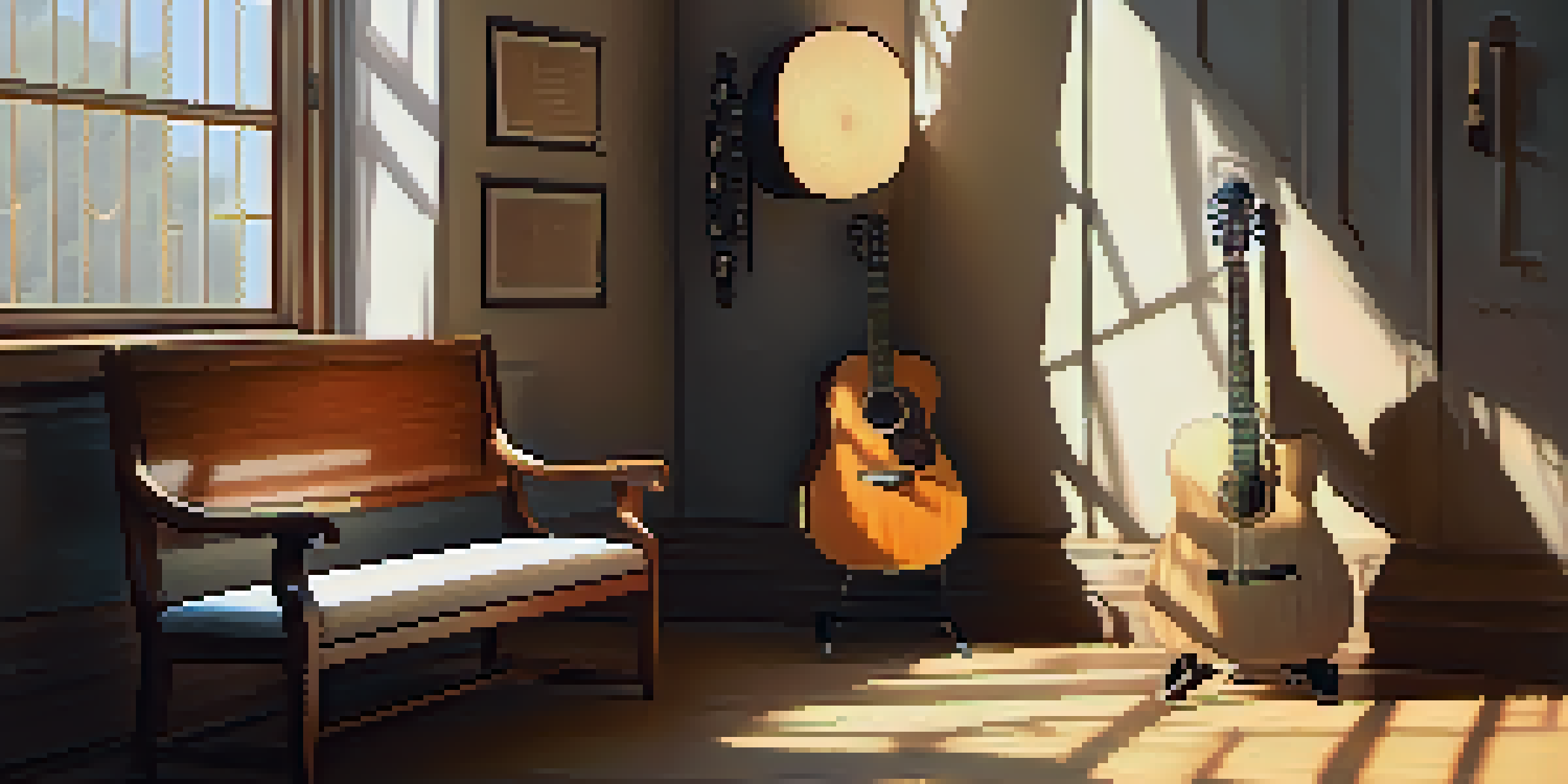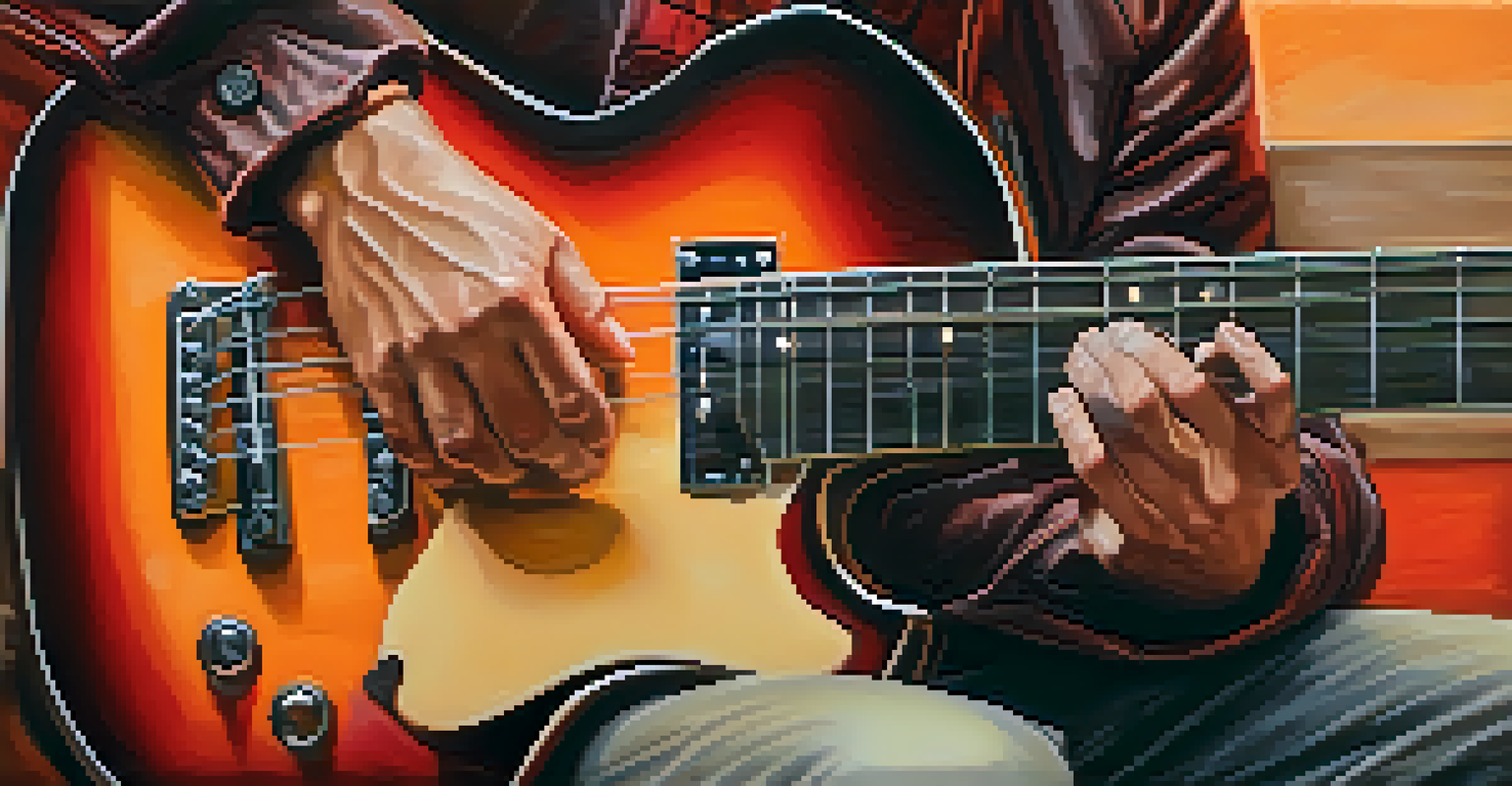Exploring Minor Guitar Scales and Their Melodic Applications

Understanding Minor Scales: The Basics
Minor scales are a fundamental aspect of music theory, adding depth and emotion to compositions. Unlike major scales, which evoke a bright and cheerful sound, minor scales tend to produce a more somber or introspective feel. This unique quality makes them a favorite among songwriters and guitarists alike, particularly in genres like rock, blues, and jazz.
Music can change the world because it can change people.
The natural minor scale consists of seven notes and follows a specific pattern of whole and half steps. For example, the A natural minor scale includes the notes A, B, C, D, E, F, and G. By understanding this structure, guitarists can easily create melodies that resonate with listeners on a deeper emotional level.
In addition to the natural minor scale, there are other variations like the harmonic minor and melodic minor scales. These scales introduce unique intervals that can enhance melodic expression, providing even more tools for guitarists to explore their musical creativity.
Exploring the Natural Minor Scale on Guitar
To get started with the natural minor scale on guitar, it's essential to learn its fingerings and positions on the fretboard. Practicing the scale in different positions can help you build muscle memory and improve your overall technique. Try playing the A natural minor scale across the fretboard, starting from the 5th fret on the low E string.

As you familiarize yourself with the scale, experiment with different patterns and sequences. For instance, you can play the scale ascending and descending, or mix it up by skipping notes. This not only enhances your dexterity but also opens up new melodic possibilities.
Exploring Minor Scales in Music
Minor scales, including natural, harmonic, and melodic variations, are essential for adding emotional depth and complexity to musical compositions.
Incorporating the natural minor scale into your playing can lead to rich and expressive solos. Many famous guitarists, such as Eric Clapton and Jimi Hendrix, have utilized this scale to create memorable riffs and solos that capture the essence of their musical style.
The Harmonic Minor Scale: A Unique Twist
The harmonic minor scale adds a distinctive flavor to your musical palette, making it a popular choice for many genres, especially classical and metal. It features a raised seventh note compared to the natural minor scale, which creates a more dramatic sound. For example, the A harmonic minor scale includes the notes A, B, C, D, E, F, and G#.
The notes I handle no better than many pianists. But the pauses between the notes—ah, that is where the art resides.
This raised seventh introduces a tension that can be resolved beautifully, making it an excellent choice for creating melodic lines that engage the listener. When playing the harmonic minor scale on guitar, you can experiment with different arpeggios and phrases to highlight its unique characteristics.
Many guitarists use the harmonic minor scale to create captivating solos over minor chord progressions. By emphasizing the leading tone (the raised seventh), you can craft melodies that evoke a sense of yearning or anticipation, adding depth to your musical expression.
Melodic Minor Scale: Expanding Your Horizons
The melodic minor scale offers a fresh perspective on melody creation, featuring a raised sixth and seventh when ascending, and reverting to the natural minor when descending. This duality gives the scale a unique sound that can be both uplifting and melancholic, depending on how it's used. The A melodic minor scale ascending would include A, B, C, D, E, F#, and G#.
Using the melodic minor scale allows guitarists to explore a variety of melodic ideas that can transcend traditional boundaries. For instance, you might create lines that blend elements of jazz and blues, showcasing the versatility of this scale.
Techniques for Practicing Scales
Consistent practice of minor scales, incorporating techniques like legato and staccato, is crucial for developing fluidity and expressiveness in guitar playing.
Incorporating the melodic minor scale into your playing can also enhance your improvisational skills. By practicing scales in different contexts, such as over various chord progressions, you can develop a deeper understanding of how to use this scale effectively in your solos.
Practical Applications of Minor Scales in Songwriting
Minor scales are not just for solos; they can also play a crucial role in songwriting. Many classic songs utilize minor scales to evoke specific emotions, making them a powerful tool for songwriters. Think of songs like 'Stairway to Heaven' or 'Black Magic Woman,' which effectively utilize minor melodies to create an emotional impact.
When writing a song, consider starting with a chord progression that emphasizes minor chords. This can set the stage for incorporating minor scales into your melodies and solos. Experiment with layering vocals or additional instruments over this foundation to create a rich, textured sound.
Don't hesitate to break the rules! Combining different minor scales can lead to innovative melodies that surprise and delight listeners. The key is to stay open to experimentation and let your creativity guide you in your songwriting journey.
Techniques for Practicing Minor Scales
To master minor scales, consistent practice is essential. Start by dedicating a few minutes each day to run through different minor scales and their variations. Using a metronome can help you develop your timing and precision, ensuring that your playing is both fluid and confident.
Incorporate techniques like legato (smoothly connecting notes) and staccato (short, detached notes) to add texture to your scale practice. These techniques can help you develop a more expressive playing style while also improving your finger coordination.
Influential Guitarists and Their Styles
Studying the approaches of legendary guitarists such as B.B. King and Joe Satriani reveals innovative ways to utilize minor scales for impactful solos.
Additionally, try improvising over backing tracks that utilize minor progressions. This will give you the opportunity to apply what you've learned in a musical context, ultimately making your practice sessions more engaging and effective.
Exploring Famous Guitarists and Their Use of Minor Scales
Many renowned guitarists have made significant contributions to the use of minor scales in their music. For example, blues legend B.B. King often employed the minor pentatonic scale to create soulful, expressive solos that resonate with audiences. His ability to convey emotion through his playing showcases the power of minor scales.
Another iconic figure is Joe Satriani, who frequently uses the harmonic minor scale to craft intricate solos that blend technical prowess with melodic beauty. His work serves as an inspiration for guitarists looking to explore the potential of minor scales in their own playing.

By studying the techniques and styles of these guitarists, you can gain valuable insights into how to effectively incorporate minor scales into your music. Whether it's through listening to their recordings or analyzing their solos, there's a wealth of knowledge to be gained from these masters of the craft.